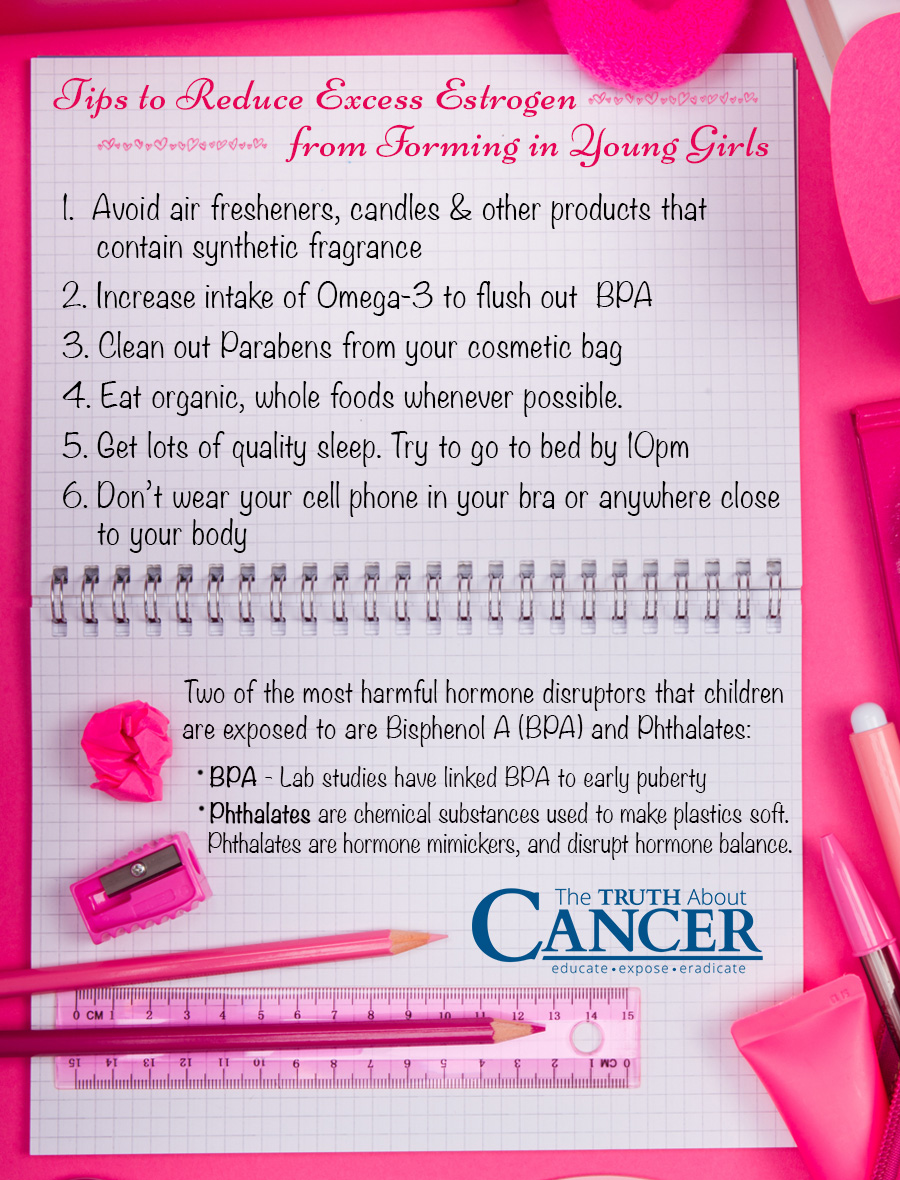Ever notice that girls are getting their periods and developing breasts at younger and younger ages? Ever wonder why? The average age for the onset of menstruation in the past fifteen years has dropped from 12 years to around 10 years of age. Breast development typically blossomed in the tween years, and now is seen in girls as young as seven. The younger girls are when they enter puberty, the greater their breast cancer risk.
There are many things lurking in your child’s life that raise her risk of breast cancer. Let’s take a look at what’s going on and how to minimize those risks.
Early Puberty Puts Girls at a Higher Risk for Later-life Breast Cancer
Early puberty may, in part, be due to childhood exposures to endocrine disruptors. These are substances that can alter the body’s hormonal responses. The evidence is mounting that these common chemicals play a role in breast cancer incidence and lab studies have linked hormone disrupters to early puberty. Breast tissue is extremely sensitive to low levels of estrogens before puberty. The younger girls are when they enter puberty, the greater their risk of breast cancer.
Two of the most harmful hormone disruptors that children are exposed to are bisphenol A (BPA) and Phthalates:
- BPA − lab studies have linked BPA to early puberty. Avoid canned foods (most are lined with BPA), use glass or stainless steel to store foods, and avoid cash register receipts. It is a little-known fact that there is more BPA on cash register receipts than in plastic water bottles! Other paper products contain BPA as well, so reduce use of paper towels and napkins, and always wash hands after handling toilet and copy paper.
- Phthalates are chemical substances used to make plastics soft. They are also found in hair products, nail polish and fragrances. Phthalates are hormone mimickers, and disrupt hormone balance.
Anyone with teenage girls knows that raging hormones are trouble enough. However, when estrogen becomes more plentiful than progesterone, we label this estrogen dominance.
This is a problem as progesterone helps to prevent breast cancer, whereas estrogen is known to promote it. Estrogen dominance is at the very heart of what promotes breast cancer. You see, estrogen and progesterone work in harmony with one another. They oppose one another to achieve balance. However, if a woman has too much estrogen and too little progesterone, the body no longer functions in perfect homeostasis, and cancer risk is elevated.
When the opposing force of progesterone is increased, the toxic effect of estrogen is decreased. Progesterone turns on genes that can prevent breast cancer from occurring and reduces the size of existing tumors − but it can’t do that if there is excess estrogen.
Tips to Reduce Excess Estrogen From Forming
Avoid air-fresheners, candles and other home products that contain synthetic fragrances. Consider “five-free nail polishes that do not use dibutyl phthalate, but also do not contain other known carcinogens such as formaldehyde, toluene, formaldehyde resin, and camphor. I happen to like LVX and Zoya, but there are many good brands available.
Did you know that extreme PMS is often indicative of low progesterone and estrogen dominance? Increasing intake of Omega 3 fatty acids can be helpful in flushing out BPA.
Clean Out Parabens From Her Cosmetics Bag
Most cosmetics are loaded with chemicals such as parabens (and phthalates). Parabens are xenoestrogens (chemical estrogens) and can mimic estrogen in the body, increasing the likelihood of early puberty. Parabens have been shown to increase the risk of breast cancer. They are commonly used as preservatives in makeup, moisturizers, hair products, and other personal care products.
Parabens can be spotted on product labels as methylparaben, propylparaben, ethylparaben and butylparaben, but keep it simple and avoid anything with the ending “paraben.”
According to a study done by the California Pacific Medical Center in San Francisco, when healthy cells are exposed to BPA and methylparabens, they started behaving like cancer cells, allowing them to grow and survive.
Does your daughter complain about PMS, allergies, headaches, dry eyes, asthma, or cold hands or feet? She may be overloaded with xenoestrogens.
Help girls to choose less toxic products. Visit the Environmental Working Group’s (EWG) Skin Deep Database to find paraben and phthalate-free personal care products. You may also want to visit the EWG’s website for a list of other known endocrine disruptors.
Clear Xenoestrogens Out the Bathroom and Kitchen
Most common cleaning products are loaded with toxic chemicals. Choose safer products and natural alternatives for the home and garden.
Added hormones and convenience foods have been making their way into our food supply and have been linked to early puberty. Obesity plays a role as well, as estrogens are made and stored in fat tissue. Serve organic, whole foods whenever possible. Meats should be grass-fed and dairy products obtained from pastured animals.
Chickens and eggs should at the very least be organic, but preferably pastured as well. Avoid conventional meats, chicken and produce whenever possible.
Cell Phones and Unnecessary Exposure to EMF Radiation
There is an alarming trend amongst girls these days − they tend to carry their cellphones in their bras. Maybe they think this is cool or just convenient, but this is a very dangerous habit. The soft fatty tissue of the breast easily absorbs radiation.
Case studies have found that breast cancer tumors were often located directly underneath the skin where a cell phone was stored. Cell phones should be turned off and stored in purses or packs when not in use.
On a side note, recently on the Today Show they presented young ladies in prom dresses… with cellphones tucked in the backs of their dresses? This is dangerous as well. Insist that your daughter carry her phone in a purse if she needs to carry it with her.
Quality Sleep Helps Reduce Breast Cancer Risk
Is your daughter getting to sleep early enough? Melatonin levels are very high in adolescence but drop dramatically after puberty, and then continue to fall steadily as we age. Compounding the problem is that melatonin spikes between 10:00pm and 2:00am. Unfortunately, most teenagers are night owls, causing them to miss the production of this valuable hormone.
Studies have shown that growth of breast cancer cells was suppressed by 75% with adequate melatonin. While supplementation can help, keep in mind that melatonin is a hormone. And, like all the body’s hormones, more is not always better. It is much better to get her to bed by 10:00pm so her body can make what it needs.
Adequate sleep also allows for the repair of DNA and damaged cells. Insufficient sleep actually causes cell damage. In fact, one study showed that limited sleep altered the normal functions of over 700 genes.
By teaching the young women in our lives these tips now (and applying them ourselves!), we can help to keep them from becoming the next generation of breast cancer sufferers.
Please help bring more awareness about breast cancer risk and prevention by sharing this article with all the young women and moms in your life.
Article Summary
Girls are entering puberty earlier than ever. One worrisome aspect is that the younger girls are when they enter puberty, the greater their breast cancer risk later on.
One reason for early puberty could be due to childhood exposures to endocrine disruptors which can alter the body’s hormonal responses.
Two of the most harmful hormone disruptors that children are exposed to are bisphenol A (BPA) and Phthalates.
Estrogen dominance is when estrogen becomes more plentiful than progesterone. Progesterone turns on genes that can prevent breast cancer from occurring and reduces the size of existing tumors − but it can’t do that if there is excess estrogen.
Parabens are xenoestrogens (chemical estrogens) and can mimic estrogen in the body. Exposure to parabens increases the likelihood of early puberty and can increase the risk of breast cancer. Read product labels and don’t use items with parabens.
Other tips to reduce toxic exposure in young girls and reduce their future risk of breast cancer (Hint: these tips are applicable for everyone!)…
- Avoid air fresheners, candles, and other products that use synthetic fragrance
- Increase intake of Omega-3s
- Don’t use any personal or beauty products containing parabens
- Serve organic, whole foods whenever possible. Meats should be grass-fed and dairy products obtained from pastured animals.
- Get good quality sleep. Try to go to bed by 10:00pm
- Keep your cell phone in a bag or purse and not in a pocket or tucked in a bra





















So many people, including young girls, sleep with their cell phones under their pillows!!! 8 hours of non-stop radiation …. to their brains!
I agree that girls starting puberty before 12 maybe not be a good sign in later life, because of their risk of breast cancer and ovarian cancer later on. In my opinion, it would be better that girls start puberty in their teens, because they are less likely to get cancer and might live to a very ripe old age. Genetics and diet might be causing girls develop very early, when they are ten or less. All the toxics that little girls are exposed to could be causing girls to hit puberty, when they are only 7,8, or 9. Are there specific diets that little girls can take that might prevent them from starting puberty so early?
My mother died of breast cancer aged 60, didn’t reach puberty til aged 17, so no correlation there..just saying ..
and learn to do Breast self exam–check out getintouchfoundation.org for a way to teach girls grades 5-12 how to do a breast self exam. educational and made for them/
I’d love to know more about the effects of boys starting puberty before the tween years and what can be done to ease the potential risks they face later in life.